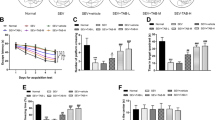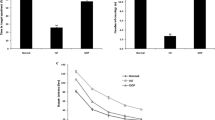Abstract
Anesthetic-induced cognitive impairment has been observed clinically. The mechanism underlying anesthetic-induced cognitive impairment is closely associated with neuronal apoptosis and neuroinflammation. Ramelteon is a potent and highly selective melatonin receptor agonist that has been used for the treatment of insomnia and has been reported to have an anti-inflammatory effect. In this study, we aimed to investigate the protective effects of Ramelteon against the cytotoxicity induced by isoflurane in brain microvascular endothelial cells. Our results show that Ramelteon ameliorated oxidative stress by suppressing the generation of mitochondrial reactive oxygen species (ROS) in human brain microvascular endothelial cells (HBMVECs). In addition, Ramelteon displayed a robust anti-inflammatory capacity against isoflurane-induced insults and inflammation by reducing the generation of interleukin-1β (IL-1β), transforming growth factor-β (TGF-β), monocyte chemotactic protein 1 (MCP-1), stromal cell-derived factor-1 (SDF-1), matrix metalloproteinase-2 (MMP-2), and MMP-9. Furthermore, Ramelteon reduced the expression of cell adhesion molecules such as intercellular adhesion molecule-1 (ICAM-1) and E-selectin. Importantly, Ramelteon downregulated the activation of the p38MAPK/NF-κB signaling pathway, which is the key transcriptional regulator in the inflammation process. Our findings in the present study provide new evidence for the use of Ramelteon in the prevention of isoflurane-induced insults in brain endothelial cells.








Similar content being viewed by others
References
Babaee A, Eftekhar-Vaghefi SH, Asadi-Shekaari M, Shahrokhi N, Soltani SD et al (2015) Melatonin treatment reduces astrogliosis and apoptosis in rats with traumatic brain injury. Iran J Basic Med Sci 18:867–872
Basuroy S, Tchereanova D, Bhattacharva S, Leffler CW, Parfenova H (2010) Nox4 NADPH oxidase-derived reactive oxygen species, via endogenous carbon monoxide, promote survival of brain endothelial cells during TNF-α-induced apoptosis. Am J Phys Cell Physiol 300:C256–C265
Cao L, Li L, Lin D, Zuo Z (2012) Isoflurane induces learning impairment that is mediated by interleukin-1β in rodents. PLoS One 7:e51431
Chow BW, Gu C (2015) The molecular constituents of the blood-brain barrier. Trends Neurosci 38:598–608
Crone C, Olesen S (1982) Electrical resistance of brain microvascular endothelium. Brain Res 241:49–55
Dehghan F, Khaksari Hadad M, Asadikram G, Najafipour H, Shahrokhi N (2013) Effect of melatonin on intracranial pressure and brain edema following traumatic brain injury: role of oxidative stresses. Arch Med Res 44:251–258
Emet M, Ozcan H, Ozel L, Yayla M, Halici Z, Hacimuftuoglu A (2016) A review of melatonin, its receptors, and drugs. Eurasian J Med 48:135–141
Engelhardt B (2003) Development of the blood-brain barrier. Cell Tissue Res 314:119–129
Esposito E, Cuzzocrea S (2010) Antiinflammatory activity of melatonin in the central nervous system. Curr Neuropharmacol 8:228–242
Flick RP, Katusic SK, Colligan RC, Wilder RT, Voigt RG, Olson MD, Sprung J, Weaver AL, Schroeder DR, Warner DO (2011) Cognitive and behavioral outcomes after early exposure to anesthesia and surgery. Pediatrics 128:e1053–e1061
Huang Z, Wong LW, Su Y, Huang X, Wang N, Chen H, Yi C (2020) Blood-brain barrier integrity in the pathogenesis of Alzheimer’s disease. Front Neuroendocrinol 59:100857
Johnson SA, Young C, Olney JW (2008) Isoflurane-induced neuroapoptosis in the developing brain of nonhyperglycemic mice. J Neurosurg Anesthesiol 20:21–28
Kim SR, Bae YH, Bae SK, Choi KS, Yoon KH, Koo TH, Jang HO, Yun I, Kim KW, Kwon YG, Yoo MA, Bae MK (2008) Visfatin enhances ICAM-1 and VCAM-1 expression through ROS-dependent NF-kappaB activation in endothelial cells. Biochim Biophys Acta 1783:886–895
Laudon M, Frydman-Marom A (2014) Therapeutic effects of melatonin receptor agonists on sleep and comorbid disorders. Int J Mol Sci 15:15924–15950
Lu Y, Wu X, Dong Y, Xu Z, Zhang Y, Xie Z (2010) Anesthetic sevoflurane causes neurotoxicity differently in neonatal naïve and Alzheimer’s disease transgenic mice. Anesthesiology 112:1404–1416
Mattila OS, Strbian D, Saksi J, Pikkarainen TO, Rantanen V, Tatlisumak T, Lindsberg PJ (2011) Cerebral mast cells mediate blood-brain barrier disruption in acute experimental ischemic stroke through perivascular gelatinase activation. Stroke 42:3600–3605
Mohaghegh T, Yazdi B, Norouzi A, Fateh S, Modir H, Mohammadbeigi A (2017) Effect of intravenous anesthesia with propofol versus isoflurane inhalation anesthesia in postoperative pain of inguinal herniotomy: a randomized clinical trial. Med Gas Res 7:86–92
Osiak W, Watroba S, Kapka-Skrzypczak L, Kurzepa J (2020) Two faces of heme catabolic pathway in newborns: a potential role of bilirubin and carbon monoxide in neonatal inflammatory disease. Oxidative Med Cell Longev 2020:7140496
Reuter S, Gupta SC, Chaturvedi MM, Aggarwal BB (2010) Oxidative stress, inflammation, and cancer: how are they linked? Free Radic Biol Med 49:1603–1616
Shen X, Dong Y, Xu Z, Wang H, Miao C, Soriano SG, Sun D, Baxter MG, Zhang Y, Xie Z (2013) Selective anesthesia-induced neuroinflammation in developing mouse brain and cognitive impairment. Anesthesiology 118:502–515
Sim TM, Tarini D, Dheen ST, Bay BH, Srinivasan DK (2020) Nanoparticle-based technology approaches to the management of neurological disorders. Int J Mol Sci 21:6070
Stratmann G, Sall JW, May LD, Bell JS, Magnusson KR, Rau V et al (2009) Isoflurane differentially affects neurogenesis and long-term neurocognitive function in 60-day-old and 7-day-old rats. Anesthesiology 110:834–848
Tao G, Xue Q, Luo Y, Li G, Xia Y, Yu B (2016) Isoflurane is more deleterious to developing brain than Desflurane: the role of the Akt/GSK3beta signaling pathway. Biomed Res Int 2016:7919640
Terrando N, Eriksson L, Ryu JK, Yang T, Monaco C et al (2011) Resolving postoperative neuroinflammation and cognitive decline. Ann Neurol 70:986–995
Tsukamoto N, Otsuka F, Ogura-Ochi K, Inagaki K, Nakamura E, Toma K, Terasaka T, Iwasaki Y, Makino H (2013) Melatonin receptor activation suppresses adrenocorticotropin production via BMP-4 action by pituitary AtT20 cells. Mol Cell Endocrinol 375:1–9
van Vliet EA, Ndode-Ekane XE, Lehto LJ, Gorter JA, Andrade P, Aronica E, Gröhn O, Pitkänen A (2020) Long-lasting blood-brain barrier dysfunction and neuroinflammation after traumatic brain injury. Neurobiol Dis 105080
Wang J, Jiang C, Zhang K, Lan X, Chen X, Zang W et al (2018) Melatonin receptor activation provides cerebral protection after traumatic brain injury by mitigating oxidative stress and inflammation via the Nrf2 signaling pathway. Free Radic Biol Med 131:345–355
Whitton PS (2007) Inflammation as a causative factor in the aetiology of Parkinson’s disease. Br J Pharmacol 150:963–976
Wilder RT, Flick RP, Sprung J, Katusic SK, Barbaresi WJ, Mickelson C, Gleich SJ, Schroeder DR, Weaver AL, Warner DO (2009) Early exposure to anesthesia and learning disabilities in a population-based birth cohort. Anesthesiology 110:796–804
Wu X, Lu Y, Dong Y, Zhang G, Zhang Y, Xu Z, Culley DJ, Crosby G, Marcantonio ER, Tanzi RE, Xie Z (2012) The inhalation anesthetic isoflurane increases levels of pro-inflammatory TNF-α, IL-6, and IL-1β. Neurobiol Aging 33:1364–1378
Yürüker V, Nazıroğlu M, Şenol N (2014) Reduction in traumatic brain injury-induced oxidative stress, apoptosis, and calcium entry in rat hippocampus by melatonin: possible involvement of TRPM2 channels. Metab Brain Dis 30:223–231
Zhang L, Zhang J, Yang L, Dong Y, Zhang Y, Xie Z (2013) Isoflurane and sevoflurane increase interleukin-6 levels through the nuclear factor-kappa B pathway in neuroglioma cells. Br J Anaesth 110(Suppl 1):i82–i91
Zhu H, Liu W, Fang H (2018) Inflammation caused by peripheral immune cells across into injured mouse blood-brain barrier can worsen postoperative cognitive dysfunction induced by isoflurane. BMC Cell Biol 19:23
Zhu C, Gao J, Karlsson N, Li Q, Zhang Y, Huang Z, Li H, Kuhn HG, Blomgren K (2020) Isoflurane anesthesia induced persistent, progressive memory impairment, caused a loss of neural stem cells, and reduced neurogenesis in young, but not adult, rodents. J Cereb Blood Flow Metab 30:1017–1030
Author information
Authors and Affiliations
Corresponding author
Ethics declarations
Experiments were designed in accordance with “the World Medical Association Declaration of Helsinki Ethical Principles for Medical Research Involving Human Subjects.” Experimental procedures were approved by the Institutional Ethics Committee at The Second Affiliated Hospital of Hainan Medical University (HMU-2-20180326).
Additional information
Publisher’s Note
Springer Nature remains neutral with regard to jurisdictional claims in published maps and institutional affiliations.
Rights and permissions
About this article
Cite this article
Wang, T., Li, Z., Xia, S. et al. The Protective Effects of Ramelteon Against Isoflurane-Induced Insults and Inflammatory Response in Brain Microvascular Endothelial Cells. Neurotox Res 39, 677–686 (2021). https://doi.org/10.1007/s12640-020-00309-7
Received:
Revised:
Accepted:
Published:
Issue Date:
DOI: https://doi.org/10.1007/s12640-020-00309-7




